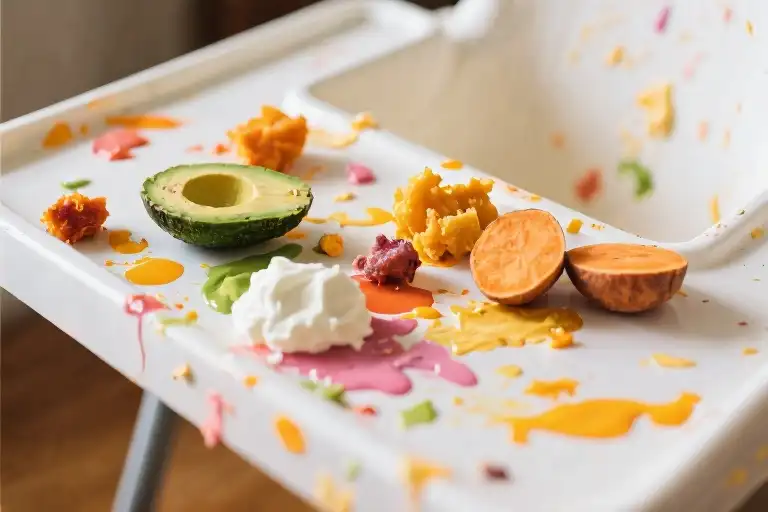The other day, a mom friend casually dropped this parenting gem over coffee: “You should try baby-led weaning—it turns your baby into this independent little genius who eats everything!” She made it sound like some magical parenting hack where I could just hand my six-month-old a steak knife and watch her become the next MasterChef Junior. No puree-making, no spoon-feeding battles—just wholesome family meals where everyone happily eats the same thing.
As someone currently drowning in laundry and sleep deprivation, I immediately latched onto two words: less work.
Guys, I went all in.
Fast forward 72 hours, and there I was—standing in my kitchen covered in sweet potato mush, desperately Googling “how to remove turmeric stains from eyeballs” while my baby cheerfully attempted to use her spoon as a javelin. Turns out, the Instagram-perfect BLW journey I’d imagined looked more like an episode of Jackass: Baby Edition.
Here’s the thing nobody tells you about baby-led weaning for beginners: those picture-perfect BLW accounts? They’re the parenting equivalent of influencer vacation photos—carefully curated to hide the sunburns, food poisoning, and marital arguments happening off-camera. The reality involves developing ninja-like reflexes (who knew spoons could be lethal weapons?), becoming disturbingly intimate with your baby’s digestive schedule (more on The Great Constipation Crisis later), and accepting that your floors will permanently resemble a modern art installation.
But between the chaos and the questionable food safety practices (note to self: babies shouldn’t actually eat takeout curry), something unexpected happened. My daughter’s face when she squished avocado between her fingers for the first time? Priceless. The way she proudly gummed a steamed carrot stick like it was a championship cigar? Worth every stained onesie.
So if you’re reading this while covered in pureed peas and questioning all your life choices, welcome. This isn’t another sterile BLW guide telling you the “right” way to do things. Consider it more of a survival manual from someone who’s currently in the trenches—complete with all the messy, hilarious fails and hard-won lessons you won’t find in parenting books. Because let’s be real: if these baby-led weaning diaries teach us anything, it’s that parenting is 10% preparation and 90% figuring out how to remove pureed pumpkin from your hair before your Zoom meeting starts.
The BLW “Sales Pitch” vs. My Reality Check
It all started with a casual mom-group chat that changed everything. “You HAVE to try baby-led weaning!” my friend exclaimed between sips of latte, her eyes sparkling with the zeal of a recent convert. “My six-month-old eats avocado slices like a pro, and we haven’t touched a single jar of puree!” The way she described it, BLW sounded like the parenting equivalent of discovering electricity – a revolutionary force that would transform messy feedings into Instagram-worthy moments of infant independence.
Like any sleep-deprived new parent, I was desperate for shortcuts. The promises were irresistible: no more spoon-feeding battles, no special baby food preparation, just plopping down whatever we were eating and watching our little one joyfully self-feed. The developmental benefits sealed the deal – according to every BLW blog and book, this method would create a future foodie with advanced motor skills and zero picky eating tendencies. I imagined family dinners where our baby would daintily nibble steamed broccoli while other parents struggled with spoon airplanes.
What nobody mentioned was the reality gap between those polished BLW Instagram accounts and actual life with an infant. The glossy photos showed babies happily gumming perfect carrot sticks, not the food-flinging tornado that entered our kitchen. Those influencer captions talked about “respecting baby’s autonomy” but never showed the 37 times per meal you have to prevent choking hazards from becoming ER visits.
My first clue should have been the disclaimer buried in the baby-led weaning guides: “Results may vary.” What they really meant was “Your experience will bear zero resemblance to these pictures.” The BLW sales pitch had me envisioning a tiny gourmet, but what I got was more like a food-covered WWE wrestler with a death wish and surprisingly good aim.
Still, armed with Pinterest boards full of beautiful BLW meal ideas and the stubborn optimism of new parents everywhere, we dove in. How hard could baby self-feeding really be? (Spoiler: The answer involved multiple bath times per meal and developing ninja-like reflexes.)
Looking back, I realize the biggest BLW lesson wasn’t about my baby’s eating – it was about managing expectations. Those picture-perfect BLW accounts are like dating profiles: carefully curated highlights that ignore the messy reality. The truth? Baby-led weaning is less about creating a miniature MasterChef and more about surviving the culinary chaos with your sanity (and walls) intact.
What followed was a journey of hilarious mishaps, unexpected discoveries, and ultimately, a deeper understanding of what feeding a tiny human really entails. If you’re considering BLW, buckle up – it’s going to be a wild (and wonderfully messy) ride.
Week 1: When Spoons Become Weapons
That first week of baby-led weaning (BLW) felt less like introducing solids and more like training for the Parenting Olympics. The event? Extreme Spoon Wrestling. The prize? Not having to explain to the pediatrician why your six-month-old smells like turmeric.
The Great Spoon Ambush
I’d read all about how BLW helps babies develop fine motor skills. What the books didn’t mention was that those “skills” would initially manifest as:
- Precise eye-poking accuracy (who knew infants could be such talented fencers?)
- Spoon-launching techniques that would impress MLB scouts
- A curious determination to use utensils as ear cleaners
Our mealtime routine quickly evolved into a bizarre dance: I’d place soft carrot sticks on the tray, baby would immediately discard them in favor of the spoon, and I’d have approximately 0.8 seconds to prevent an ocular catastrophe. My reflexes sharpened to ninja-level speeds – catch the spoon mid-air, wipe the face, retrieve food from hair, repeat.
The Curry Incident
Then came the fateful Tuesday dinner. In what I now recognize as a classic BLW beginner mistake, I thought “family meals” meant we could all enjoy the same mild chicken curry. Three things became immediately apparent:
- Babies have no concept of “mild”
- Turmeric stains everything
- Eyeballs really don’t appreciate Indian cuisine
As my daughter rubbed her curry-coated hands directly into her eyes (with the spoon still clutched like a tiny Excalibur), I experienced what can only be described as a parental out-of-body event. In one fluid motion, I:
- Caught the descending spoon
- Used my sleeve to wipe her face
- Knocked over my water glass
- Somehow still managed to take a photo for the baby book
Safety Lessons Learned
That week taught me crucial BLW safety rules they don’t put in the Instagram ads:
- Utensil strategy: Start with stubby, rounded baby spoons (regular teaspoons are basically baby rapiers)
- Food consistency: Anything soft enough to gum should also be soft enough to not cause damage when (not if) it gets flung
- Parent positioning: Sit beside baby rather than across to improve reaction time
- Emergency prep: Keep damp cloths in every room (you’ll use approximately 37 per meal)
By Friday, I’d developed a sixth sense for impending utensil danger. My husband walked in to find me eating left-handed while my right arm hovered in permanent defensive position. “How’s the self-feeding going?” he asked. I simply pointed to the curry stain on the ceiling.
The Silver Lining
Despite the chaos, we started noticing small victories:
- Those frantic grabs at the spoon? Actually developing hand-eye coordination
- The food-flinging? Early physics experiments about gravity
- The mess? Sensory exploration that’s crucial for brain development
Most importantly, we both learned that BLW isn’t about perfect meals – it’s about embracing the messy, hilarious process of discovery. Even if that discovery involves learning exactly how far a pureed pea can travel when launched from a high chair.
Next week’s episode: When “just a pinch of salt” leads to very big problems…
Week 2: The Salt Saga and Constipation Chronicles
That picturesque family dinner scene I’d imagined? The one where my baby happily munches on seasoned salmon and roasted veggies alongside us? Yeah, that lasted exactly one meal. Here’s what actually happened during our second week of baby-led weaning (BLW) – a crash course in infant nutrition that no Instagram post prepares you for.
The Great Salt Misunderstanding
Like many BLW beginners, I assumed “eating what we eat” meant identical meals. Our pediatrician’s face when I casually mentioned adding a pinch of salt to my 7-month-old’s sweet potato? Priceless. “Their kidneys can’t process sodium like ours can,” she explained, handing me an AAP guideline printout that might as well have been titled “How to Parent 101.”
Key Lesson:
- Babies under 12 months need less than 1g salt daily (naturally occurring in foods is enough)
- Common offenders: bread, cheese, canned veggies, and yes, that “tiny pinch” we think doesn’t count
Single-Ingredient Gatekeeping
The constipation started on day three. My previously regular baby turned into a tiny, red-faced volcano erupting… nothing. Turns out, introducing multiple new foods simultaneously (avocado! chicken! quinoa!) wasn’t the independence boost I thought – it was a digestive system ambush.
What Worked:
- Reverting to one new food every 3 days (the “BLW for beginners” golden rule)
- Constipation remedies:
- P-prunes (nature’s laxative)
- B-bicycle legs (10 mins after meals)
- W-water sips (tiny amounts with solids)
The BLW Reality Check
Between frantic Googling of “baby constipation after starting solids” and singing poop-themed nursery rhymes (parenting gets weird fast), I realized BLW isn’t about replicating adult meals. It’s about:
- Letting babies explore textures (even if 90% ends up in their hair)
- Watching for readiness cues (palmar grasp vs. pincer grasp matters)
- Embracing the mess as sensory development (science says so!)
Pro Tip: Keep a “BLW first foods” journal to track reactions. Our lifesaver format:
| Date | Food | Reaction | Diaper Notes |
|---|---|---|---|
| 6/12 | Carrot | Gagged, then smiled | Normal |
Silver Linings Playbook
By week’s end, we’d:
- Mastered the art of unsalted roasted veggies (protip: cinnamon adds baby-safe flavor)
- Learned that “BLW mistakes to avoid” lists exist for a reason
- Discovered our baby’s love-hate relationship with prunes (face: disgust, hands: grabbing for more)
As I scrubbed sweet potato out of the high chair crevices (how?!), it hit me: BLW isn’t about perfect meals. It’s about that proud moment when your baby finally… successfully… gets one pea into their mouth. Even if the other twelve are in your shoe.
Next Week Preview: When “food play” crosses into modern art territory (and why that’s actually okay).
Week 3: Food or Finger Paint?
If Picasso had practiced baby-led weaning, his Blue Period might have been renamed the Mashed Potato Period. Our kitchen during Week 3 resembled a modern art studio more than a dining space – with sweet potato smears on the highchair tray becoming abstract expressionism, and avocado chunks strategically flung to create installation art on the floor.
The Sensory Science Behind the Mess
While scrubbing pureed peas off the walls for the third time that day, I stumbled upon fascinating research about tactile exploration. Turns out, those chaotic food-flinging sessions are actually wiring your baby’s brain for cognitive development. When little fingers squish bananas or smear yogurt, they’re:
- Building neural pathways through temperature/texture discovery
- Developing hand-eye coordination with each (failed) spoon-to-mouth attempt
- Learning cause-effect relationships (“When I drop carrots, mom makes funny noises!”)
Pediatric occupational therapists confirm that messy eating accelerates sensory integration – though they probably didn’t envision curry powder as part of the curriculum.
Safety Meets Creativity
We developed survival strategies for this artistic phase:
- The Naked Chef Approach: Strip baby down to diaper before meals saves 3 outfit changes daily
- Splat Mat Investment: A $20 waterproof mat under the highchair preserves sanity (and flooring deposits)
- Strategic Food Choices: Steam broccoli florets become natural paintbrushes, while chia pudding makes excellent “texture paint”
The Great Yogurt Incident
Wednesday’s breakfast became legendary when my aspiring Jackson Pollock discovered yogurt’s projectile potential. As Greek yogurt rained down like modern art confetti, I learned:
- The ceiling fan’s rotation speed directly correlates with splatter radius
- Dogs are nature’s cleanup crew (though subsequent gas emissions require ventilation)
- Baby giggles during food-flinging provide better stress relief than any meditation app
Progress Report
Amidst the chaos, real skills emerged:
- Pincer grasp refinement through cheerio pickups
- Color recognition (“Red pepper! Yellow squash!”)
- Early physics lessons (gravity testing via dropped utensils)
BLW Pro Tip
Keep a “food art” photo album – those avocado masterpieces make hilarious first birthday party decorations. Just maybe avoid serving the same foods at the celebration unless you want a live reenactment.
As I mopped sweet potato off the cabinets (how did it get behind the microwave?), I realized this wasn’t just about nutrition. We were raising a tiny scientist conducting delicious experiments, one messy meal at a time.
The Real Lesson of BLW: Growing Together
If there’s one thing these three weeks of baby-led weaning have taught me, it’s that parenting manuals should come with a disclaimer: “Results may vary…wildly.” What began as a quest to raise an independent little eater quickly turned into a masterclass in humility, reflexes I never knew I had, and an intimate knowledge of infant digestion patterns.
Three Hard-Earned Lessons for BLW Beginners
- Safety First Doesn’t Mean Perfect Execution
That spoon incident in Week One wasn’t just a fluke – it was a wake-up call. Pediatric occupational therapists emphasize that self-feeding skills develop gradually between 6-12 months. We learned to:
- Use stubby silicone spoons with curved handles
- Always sit facing baby during meals (goodbye, multitasking)
- Keep a damp cloth in each pocket like some kind of high-stakes janitor
- Their Timeline Isn’t Your Timeline
Our Week Two salt-and-constipation debacle revealed a crucial BLW truth: Babies aren’t tiny adults. Their kidneys can’t process sodium like ours, and their digestive systems need single-ingredient introductions. The game-changing realization? BLW isn’t about family meals—it’s about letting baby explore textures at their pace. We started:
- Prepping unsalted versions of our food
- Introducing one new food every 3 days (banana: success, avocado: epic fail)
- Celebrating food smearing as “sensory exploration” rather than “wasted organic sweet potato”
- The Mess Is the Point
By Week Three, our kitchen resembled a modern art studio, and that’s when it clicked: BLW isn’t a feeding method—it’s a crash course in relinquishing control. Research shows that messy play with food helps babies develop oral motor skills and reduces picky eating later. We now:
- Lay a shower curtain under the high chair (game changer)
- Dress baby in just a diaper during mealtimes
- Take photos of food-covered faces instead of stressing about cleanup
The BLW Diploma No One Talks About
Completing these first weeks earns you invisible badges:
- Level 5 Reflexes: Dodging airborne carrot sticks
- Advanced Poop Analysis: Identifying quinoa in diapers
- Zen Mastery: Smiling through the 10th yogurt facial of the day
At its core, baby-led weaning mirrors parenting itself—a series of small surrenders. You relinquish pristine floors for giggles when spaghetti hits the wall. Trade efficiency for the wonder in their eyes as they squish blueberries between fingers. The real “led” in BLW? Letting your child lead you to rediscover joy in life’s beautiful messes.
So to every parent staring at a food-smeared high chair: You’re not failing. You’re both learning. And someday, when your toddler proudly uses a spoon without launching it across the room (mostly), you’ll laugh remembering these early days. Because perfect parents don’t exist—but the ones who survive BLW with their humor intact? Those are the ones kids remember.





